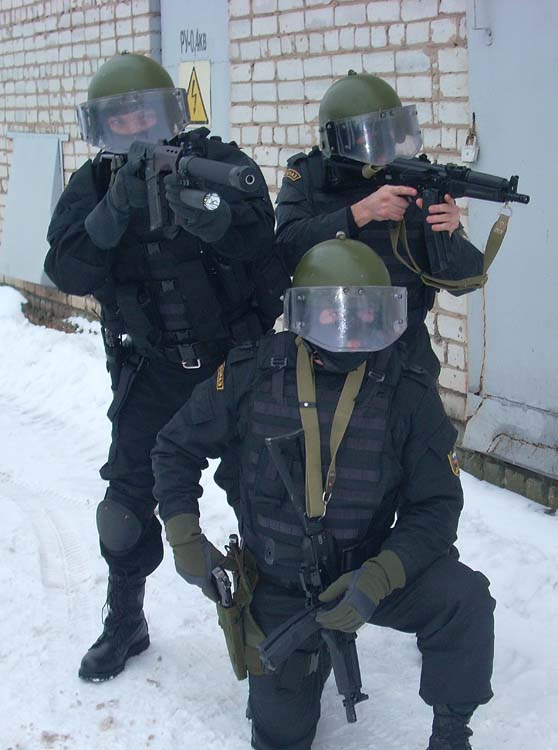
By the late 1980s, special operations elements of the Soviet Army, Internal Affairs Ministry and KGB were well equipped with silenced weapons which covered most bases and practical ranges. However, the rise of organized crime and political disturbances in the USSR during the late 1980s increased demand for other types of weapons, previously overlooked by Soviet “Force Departments.” In 1989, the 9th Department of the KGB, which was responsible for VIP protection, issued a request for a compact, easily concealable automatic weapon which would be significantly more powerful than the old Stechkin APS machine pistol, the preferred weapon of many Soviet VIP security teams of the time. The request was handed over to the Central Institute of Precision Machine Building (TsNII TochMash), a state-owned organization that was responsible for the development of most specialized small arms.
The feasibility study at TsNII TochMash began by converting a silenced 9×39 AS assault rifle. The bulky integral suppressor was discarded and the ports in the barrel blocked by a compact steel jacket, pressed over the muzzle part of the barrel. A new front sight was fitted and the weapon was tested as the MA – “Malogabaritnyj Avtomat Vikhr” (small-sized automatic rifle, code-name “Whirlwind”). The test of the MA showed enough promise to warrant further development, which was commenced under the factory designation RG051. The main goal was to make the new weapon as compact and concealable as possible. To achieve this, the rigid side-folding shoulder stock was replaced by a somewhat less comfortable but less space-consuming top-folding stock, and the fixed charging handle, which protruded from the right side of the gun, was replaced by dual sliders located above the fore end. To achieve faster transition from carry to combat mode, the safety lever was redesigned to provide easier handling, and was made ambidextrous. The top-folding stock was fitted with a powerful spring that automatically opened it into the ‘ready’ position once the user hit the lock button. The latter feature didn’t survive for long, however, as during one of the early demonstrations to senior KGB executives, one unlucky officer hit the lock button without knowing its effect, and got hit in the face with the automatically unfolding buttstock.
The first pre-production RG-051 weapons were delivered to the KGB in 1991, and after extensive field testing in 1996 the new weapon was designated SR-3 and adopted by the KGB’s successors, the FSB (Federal Security Service) and FSO (Federal VIP Protection Service). The weapon was manufactured by the same TsNII TochMash organization and on the same machinery that was (and still is) used to manufacture the suppressed AS and VSS weapons. Like many other TsNII TochMash products, the SR-3 was a ‘niche’ weapon. It was mostly intended for VIP protection, although some elite counter-terror units in Russia also got hold of these compact but powerful guns, which are well suited for CQB scenarios when opponents could be wearing body armor or hiding behind hard barriers. Despite the lack of the sound suppressor it was an excellent weapon for many police duties, but it was too expensive and too optimized for concealed carry. A demand arose for a weapon with similar capabilities, firing similar 9×39 ammo, but of more affordable cost and with better tactical flexibility. The famous Instrument Design Bureau (KB Priborostroenija or KBP in short) decided to fill this niche.
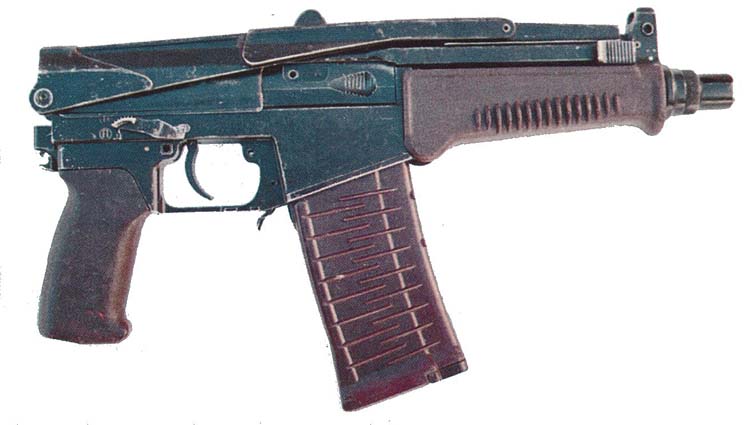
The goal of the new development, which was carried out with the company’s own funds, was to create a new CQB weapon for police use that would be lighter than the ubiquitous Kalashnikov 5.45mm AKS-74U compact assault rifle, while offering better stopping power and barrier penetration. Additionally, the new weapon had to be relatively inexpensive to make and maintain. These desired targets were achieved by selecting the 9×39 subsonic AP ammo as the core of the new system, which was designated 9-A91. Other goals were achieved by designing a new weapon from scratch, using standard manufacturing techniques and dispensing with the Kalashnikov heritage.

The new weapon was also gas operated and utilized a more or less conventional rotary locking bolt, but it was almost a kilogram lighter than AKS-74U without the magazine. Extensive use of steel stamping and forming technologies helped to keep the cost down, and the first batches of the 9-A91 weapons were delivered to the MVD users in 1994. Since the original 9×39 SP-6 AP ammunition was quite expensive, KBP also took the time and effort to design a less expensive alternative, the PAB-9 AP cartridge in the same caliber. It also used a steel core but this was made by stamping rather than machining, and other cost-saving measures were introduced in the bullet manufacture. As a result, this cartridge worked well in the 9-A91, but caused excessive wear to the barrels of the AS, SR-3 and especially VSS weapons in the same caliber. For this reason, production of the PAB-9 ammunition, which was manufactured at the Tula Cartridge works, ceased by the late 1990s.
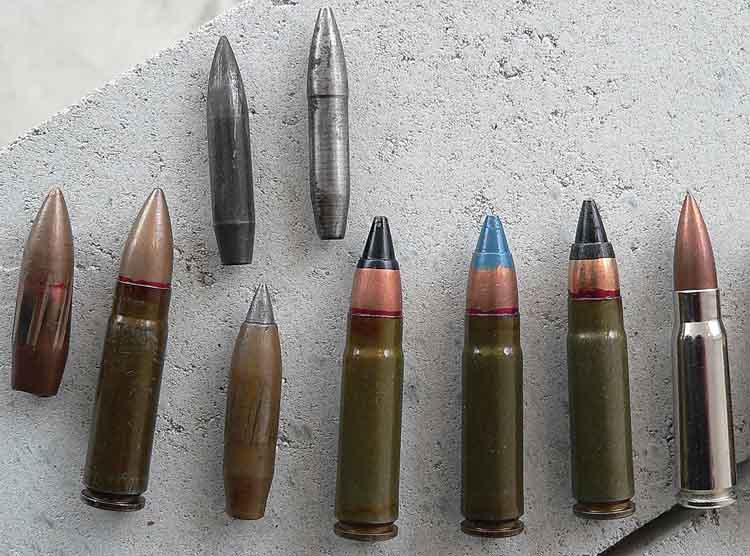
Following initial field testing of the 9-A91, KBP responded to user requests by improving the weapon. The primary changes, introduced in 1995, included a quick-detachable suppressor and a side-rail for mounting optical sights. Since the rail occupied most of the left receiver wall, the safety/fire selector lever was moved to the right side of the gun.
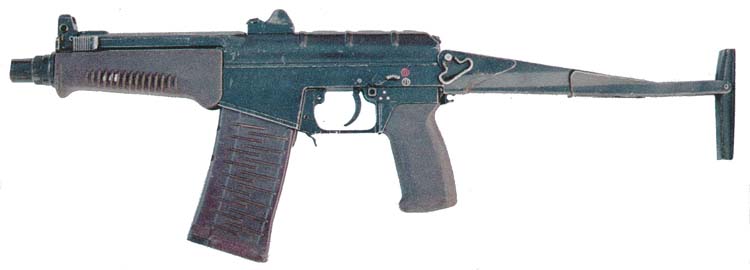
In view of the initial success of the 9-A91, KBP decided to build a family of weapons using the same basic design. One approach they tried was to convert the 9-A91 to fire pistol-caliber ammunition, such as the 7.62×25, but only one or two prototypes were built. Another approach was to try and develop a more economical alternative for the VSS silenced sniper rifle, firing the 9×39 SP-5 sniper ball ammunition. Work on this version commenced in 1994, and shortly afterwards a new weapon was offered to all law enforcement organizations across Russia. Designated VSK-94, it was nothing more than the 9-A91 rifle, hand-picked at the factory for best accuracy, and fitted with a non-folding skeletonized shoulder stock and a PSO-1-1 4X telescopic sight, calibrated for 9×39 ammunition. VSK-94s were also equipped with the same quick-detachable suppressors as the post-95 9-A91 rifles. These sniper rifles also retained the selective-fire capability of their parent weapon. Both the 9-A91 and the VSK-94 became quite popular among Russian law enforcement units, especially various OMON and SOBR SWAT-type teams that were engaged in fighting terrorism and organized crime. Since 2004, the VSK-94 has also been officially adopted by the Russian Army to complement the somewhat more accurate, but also more expensive, VSS sniper rifles used by Army Spetsnaz and reconnaissance units.
During the early 2000s, TsNII TochMash decided to develop a similar weapon to the 9-A91 to extend its market presence. The new SR-3M compact assault rifle, which is now in limited use by various FSB and police Spetsnaz units across Russia, is a mix of the original features of the AS and SR-3 weapons. Basically, it’s the AS rifle fitted with a non-ported barrel, a new fore end with an integral folding fore grip, and the new quick-detachable suppressor, so it can be fired in both suppressed or standard configurations depending on the mission profile. Also, in response to end user requests, TsNII TochMash developed a new 30-round magazine to complement the older 10- and 20-round magazines, manufactured for the AS, VSS and SR-3.

According to end user reports, both the SR-3M and 9-A91 weapons are excellent CQB tools. Both have the traditional high reliability of Russian military small arms and provide significant stopping power and hard barrier penetration at ranges of up to 100-150 meters (the SP-6 AP bullet can go through 6mm of mild steel at 100 meters range). Both can be used with suppressors as required, and both are often fitted with low-magnification telescopic or red-dot sights. The VSK-94 is also popular for short-range precision work, although its accuracy is certainly not up to the demanding standards of Western police snipers. With SP-5 ball ammo it can deliver 2-4 MOA accuracy at ranges of up to 300-400 meters, which is usually enough for its intended role. For more accurate work, police units are usually equipped with more traditional sniper rifles firing more powerful 7.62x54R ammunition, such as SVD or SV-98.
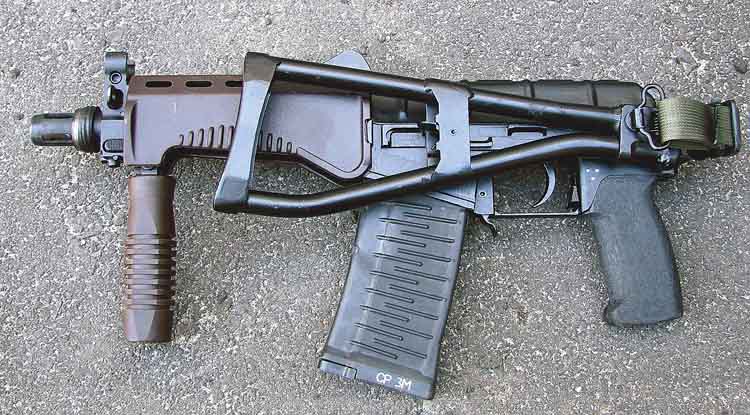
Many exclusive photos were kindly supplied by Russian Police Spetsnaz operators who prefer to remain anonymous except for their semi-official call signs “Karden” and “Junker81”.
Specifications and technical descriptions
Ammunition
All 9×39 ammunition is loaded into Berdan-primed steel cases with a lacquer coating. No headstamps are provided on SP-5 and SP-6 ammunition. SP-5 bullets are fully jacketed, with a tombac-plated steel jacket. The core is of the combination type – the front part of the core is made from steel, the rear part from lead. SP-6 bullets are semi-jacketed with the same tombac-plated steel jacket, but the pointed steel core/penetrator projects from the front of the bullet and the space between the penetrator and the jacket is filled with a thin layer of lead. The penetrator is made from hardened tool-grade steel and usually separates from the jacket when hitting armor plate or other hard barriers: the penetrator goes inside the target while the jacket remains outside the barrier/armor plate. When hitting soft armor or body tissue the SP-6 bullet normally stays intact, thus ensuring conformity with international conventions on warfare. Penetration for the SP-6 cartridge is usually listed as 7-8 mm (about 1/3 of an inch) of mild steel at 100 meters, or “guaranteed penetration of Class Three body armor at 400 meters.” The “Class 3” body armor, according to Russian standards, ensures protection against all conventional pistol rounds as well as against standard 7.62×39 ball bullets, fired from an AK assault rifle. The SP-5 bullets are unmarked, while SP-6 AP bullets are marked with black paint over the tip of the bullet.
The PAB-9 ammunition offers performance similar to that of the SP-6, but may cause excessive wear to the barrels of the AS, VSS and SR-3 weapons, so it should be used only in the 9-A91 and VSK-94 rifles. Unlike the SP-5 and SP-6 ammunition, the lacquered steel cases of the PAB-9 ammo bear standard Tula Cartridge Works headstamps with factory code, year of manufacture and caliber information. PAB-9 bullets are also marked with black paint over the tip of the bullet.
Newest in the line of 9×39 cartridges is the SPP “Sniper, Improved Penetration” loading, which features a hardened steel core, exposed at the nose like in SP-6 AP bullet, but the core is noticeably shorter. It is marked with blue tip and accuracy-wise it is on par with SP-5 ball (ballistics are also the same), but its penetration against body armor is close to the SP-6 AP. Not surprisingly, it is most expensive version of all 9×39 variants currently in production.
SR-3 and SR-3M Compact Assault Rifle
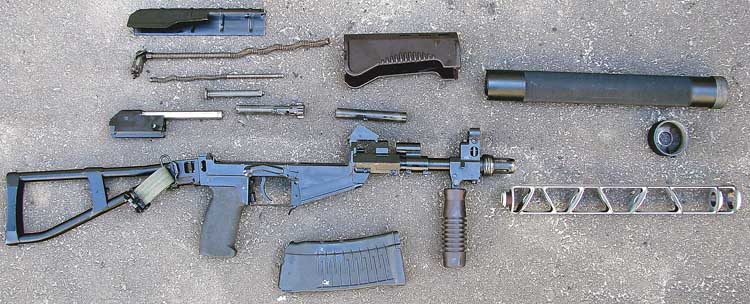
The SR-3 is a gas operated, selective-fire weapon. Its receiver is machined from a steel forging for improved strength and durability. The long-stroke gas piston is located above the barrel and is rigidly attached to the bolt carrier. The rotating bolt has six radial lugs and locks into the receiver. The bolt charging arrangements on the SR-3 consist of dual sliders, located above the barrel. To manually cycle the bolt, the user has to grip these sliders with his fingers and pull to the rear, then release. When the gun is fired, the sliders remain stationary. To facilitate manual bolt closure in the event of a failure to close the bolt completely, the right side of the bolt carrier has a tear-drop shaped and serrated dimple, accessible through the ejection port. When required, the user has to put his finger into this dimple to force the bolt carrier forward. The SR-3M reverts to a conventional cocking handle, permanently attached to the right side of the bolt carrier.
The trigger unit is somewhat similar to that of the Czech-made Sa.Vz.58 assault rifle, and is striker-fired. The striker spring is located below the bolt return spring, and both springs are assembled into the captive unit with spring guides and a polymer bolt buffer attached to the rear plate of the unit. The safety levers are ambidextrous and located above the trigger guard. On the SR-3M, the non-ambidextrous safety lever is similar to the one found on all Kalashnikov-type rifles. The fire mode selector is a separate cross-bolt button (on SR-3) or lever (on SR-3M), located within the trigger guard, just behind the trigger. The selector positions are marked with white dots on the pistol grip: three dots on the left side mark the full-automatic setting, and a single dot on the right marks the single-shot mode.
The flip-up rear sight has an L-shaped blade with settings for 100 and 200 meters. Both front and rear sights are protected, and the sight line is relatively short. The SR-3M is provided with a typical Russian side rail mount that accepts standard scope mounts; in view of their CQB role, these weapons are often fitted with red-dot sights.
The SR-3 is equipped with a compact muzzle brake/flash hider and cannot accept any suppressor. The quick-detachable suppressor for the SR-3M is of a conventional expansion type. It has seven baffles made from stamped steel and welded into a single removable unit. The suppressor is attached to the gun via short threads at the base of the modified flash hider/muzzle brake, with a plunger-type lock below the muzzle. The service life of the suppressor is normally equal to that of the entire gun system.
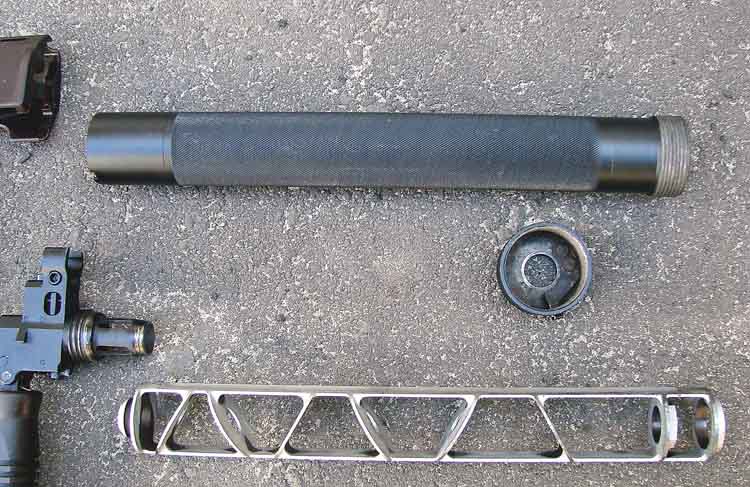
The furniture of the SR-3 consists of a short polymer fore end, a polymer pistol grip and a top-folding shoulder stock made from stamped steel. The SR-3M is fitted with a side-folding skeletonized shoulder stock, borrowed from the AS rifle, which is made of steel tubes with a plastic buttplate. It folds to the left side of the gun and does not interfere with the controls so the weapon can be fired with the stock folded. The SR-3M is also provided with an integral folding fore grip attached to the front of the fore end.

The SR-3 is usually issued with 10- and 20-round double stack, double feed magazines, made from plastic, and compatible with the AS and VSS rifles. The SR-3M rifle can use the same magazines but is normally issued with newly developed stamped steel magazines with a 30-round capacity.
9A-91 and VSK-94
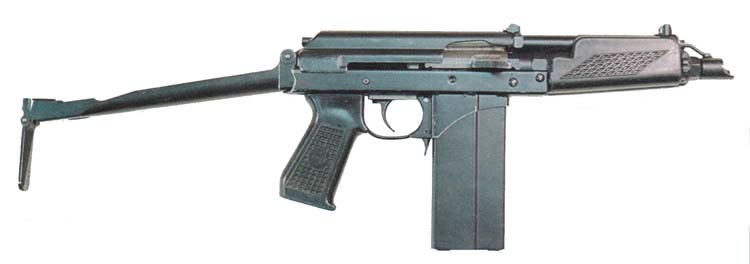
The 9A-91 rifle is a gas operated, selective-fire weapon that utilizes a long-stroke gas piston, located above the barrel, and a rotating bolt with 4 radial lugs. The charging handle is located on the right side of the bolt carrier. (It was welded solid on early production guns, or can be folded up on current production guns.) The safety/fire selector lever was located at the left side of the receiver on early guns (made before 1995), but has since been relocated to the right side to clear space for the sight mounting rail. The safety/fire selector lever on both 9A-91 and VSK-94 has three positions and allows for single shots and full automatic fire. The receiver is made from steel stampings and the fore end and pistol grip are made from polymer. Feed is from a double stack, double feed straight box magazines with a 20-round capacity, made from stamped steel. These magazine are not interchangeable with other families of 9×39 weapons, such as the AS / VSS / SR-3.

The barrels of the 9-A91 and VSK-94 are threaded at the muzzle. Early production 9-A91 rifles were issued with spoon-type muzzle flip compensators, but current production guns of both types are issued with screw-on suppressors of typical multi-baffle design. When the suppressor is not fitted, the muzzle threads are protected by a simple screw-on nut. Both guns can be routinely fired with or without the suppressor, depending on the mission profile.
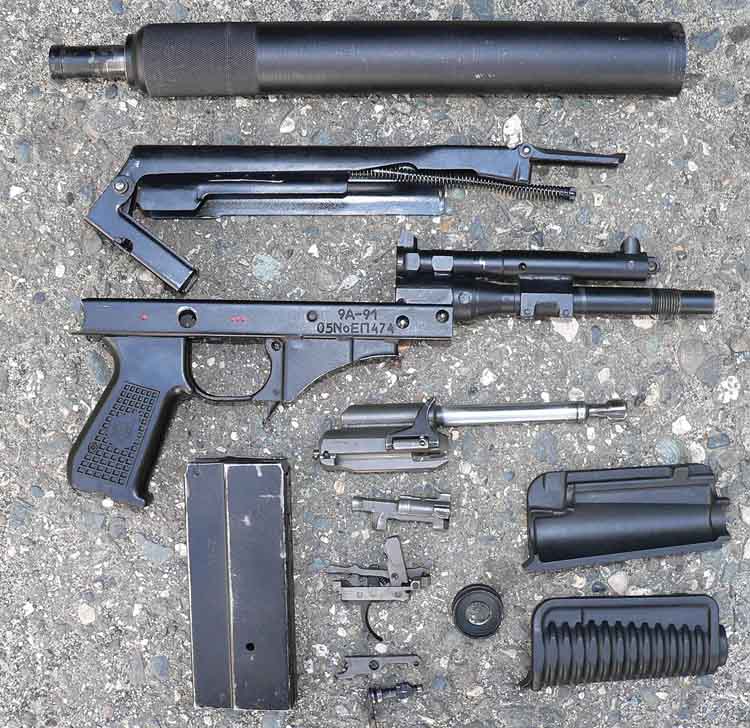
The stamped steel buttstock folds up and above the receiver when not in use. On the VSK-94 the polymer buttstock and pistol grip are made as a single unit and can easily be detached for storage or transportation. The pistol grip on the VSK-94 is hollow and is used to store the muzzle protector nut when the suppressor is installed on the gun.

On the 9-A91 the L-shaped flip-up rear sight has settings for 100 and 200 meters range. On the VSK-94, the rotary rear sight is “+” shaped and has 4 settings, from 100 to 400 meters, but it is most often used with a 4X PSO-1-1 telescopic sight or some type of night sight, installed using the standard side mount on the left side of the receiver. 9A-91 rifles are often used with some type of red dot sight, more often than not of non-standard, aftermarket variety, as standard issue Russian red dot sights are usually far too heavy and bulky.
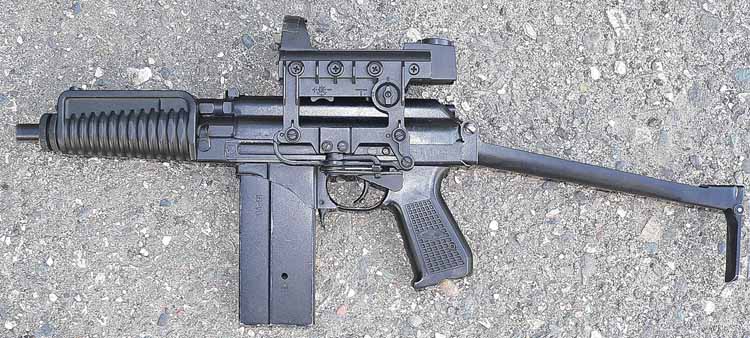
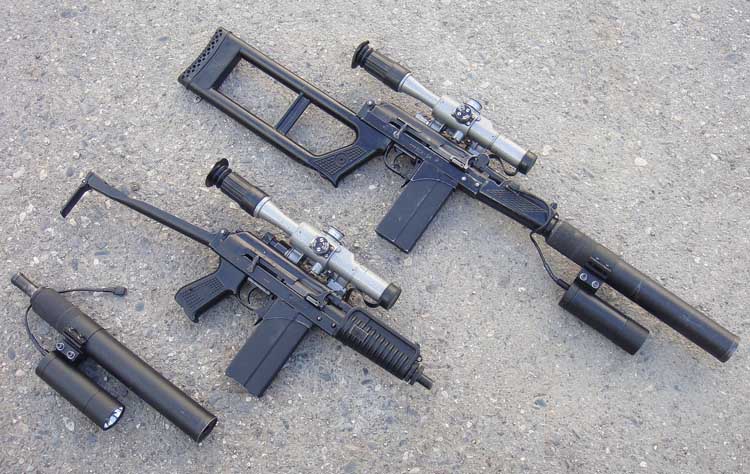
VSK-94 (top) and 9-A91 rifles compared. Note that both are equipped with PSO-1-1 4X telescope sights and Russian-made Zenith tactical lights on proprietary mounts. 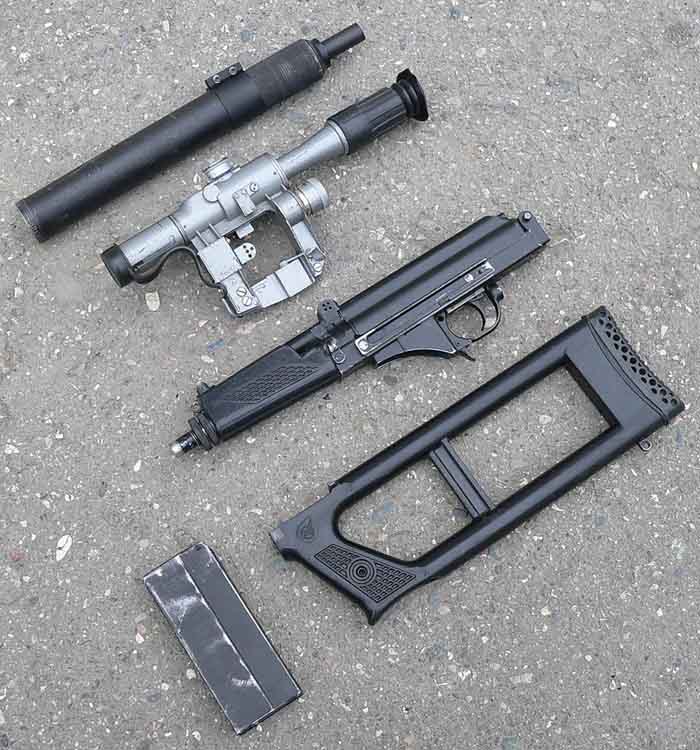
VSK-94 rifle disassembled into major components for compact storage or transportation. 
VSK-94 rifle with PSO-1-1 4X telescope sight and suppressor.

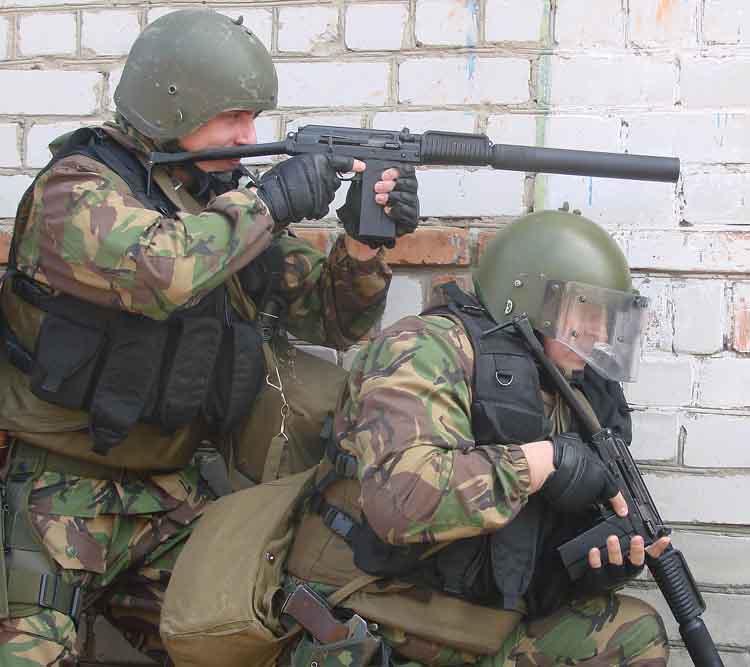
| This article first appeared in Small Arms Review V15N5 (February 2012) |











